Several times over the past few years I have seen wide angle add-on lenses and wondered how well they actually worked. So, recently I saw a really low-cost wide-angle add-on that I could not resist – Zeikos ZE-WA58B for just $13.19 from Amazon! Setting my hopes and my expectations as low as the price I ordered it … looking forward to find out how good or bad it was. As I was having a reasonable wide angle zoom already – Sigma 10-20mm f/4-5.6 EX DC HSM for $480 – I thought it would be fun 😉 comparing them to each other! Putting up some sample pictures! But I can – even without testing – say that the Zeikos will be worse and the Sigma will be better! That said, can I bring this little add-on with me as a replacement to my Sigma lens when I am lazy? At this low price is the Zeikos usable for anything?
I should point out that at no place does Amazon actually say that this is suitable to the Canon 18-55 mm kit lens. There are other similar looking add-ons that states this but I picked this because the picture showed a slightly more wide front lens. This was, I am sorry to say, not the case with the delivered product – it looks very similar to most of the other low-cost wide-angle add-ons!
The assumption that it would be suitable to my Canon kit lens is made by me! Well … the threads should work at least… 😉
Also see my other reviews for Wide Angle Add-Ons!
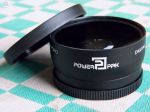 Power Pak 0.45x Add-On in part 2!
Power Pak 0.45x Add-On in part 2!
 EMOLUX 0.45x PRO HD Add-On! NEW Review!
EMOLUX 0.45x PRO HD Add-On! NEW Review!
 $2 Wide Angle clip-on for mobile phones!
$2 Wide Angle clip-on for mobile phones!
Now on to the Zeikos ZE-WA58B 0.45x Wide Angle review:
Fair comparison to the Sigma lens? Pricewise – NO! Claimwise – ABSOLUTELY! Just for fun – listen to this from the box of the Zeikos ZE-WA58B:
- Professional High Definition Wide Angle Lens – this is very hard to understand what it really means – but is sure sounds as if it is supposed to be something really GOOD!
- Titanium Optics – well your guess is as good as mine where the Titanium is used – I guess it is supposed to impress – and it IS impressive as it IS in fact rocket science (Check this at NASA)
- Digital multi-coated – this is something the big brand guys use – not that I know what the “Digital” is in this context …
- Heavy Duty Construction – not that difficult to grasp
- 0.45x – what does this mean? Guess: 0.45x the focal length? My kit lens 18-55 mm would turn into 8-25 mm which is quite impressive! It would beat my Sigma 10-20 mm in both “ends”!
- 58 mm – this is just the lens filter diameter – it fits my 18-55 mm kit-lens
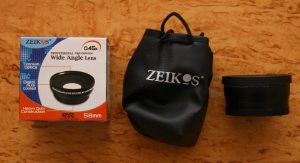 The Box
The Box
As you can see in the picture at the left, the box contains a (rather flimsy) pouch and the wide-angle lens itself. The lens is covered by a press-on lens cap at the front and a screw-on cap at the back. There is also a one-page “manual” that says what one-page “manual” usually says! That is not much – but it states that you should not use lens-paper but microfiber cloth. This could indicate that the lens is very sensitive to rubbing – making me wonder about the multi-coating … but you can not expect everything for $13!
The Outside
Starting with the outside it is actually surprisingly well-built. Heavy Duty Construction? Maybe..! Let me be clear: It is NOT the product that is show on either the Amazon site or the box! It is not at all widening as much towards the front lens.Still, the finish is a good velvety black. It is very difficult to see any of the usual telltale of multicoating – the lens (at least now when it is all new) is extremely clean – not a single little speck of dirt on the lens surfaces! So I once again ask myself is there any multi-coating or for that matter any coating at all? But it is actually stating it right there on the box!
The Test
I tested it on the Canon EOS 550D (Canon Digital Rebel T2i) with kit lens 18-55 mm 3.5-5.6 IS one late afternoon when I hurried to catch the last sun rays of the day. “P“- mode. Most settings in normal or standard except contrast +1, saturation +1, sharpness +1. The sample pictures below has not been edited in any way except the name change! (I might try to test it during daytime to see if that matters in any way.)
Usage
You actually screw this wide-angle adaptor/lens onto your ordinary lens!
- The model that I bought fits only 58 mm filter threads. It fits quite snuggly on the camera lens. Weighing in at 120 gr it is not directly heavy … It has 62 mm filter threads so you can screw on a filter or a lens hood if you want to.
(Here I have to comment on the fact that (to my knowledge) all over the world we talk about focal length and filter threads in millimeters! Even in non-metric counties! 🙂 )
Impression
This “lens” consists of two screwed together parts: first the wide-angle lens itself that is the top part – a little bulging outwards – as you can see in the picture. Then there is a close-up “macro” lens – the narrow part in the picture – with the red text “MACRO“. They can either be used together as the wide-angle add-on or you can use just the close-up macro lens.
Autofocus works well, both with the ordinary phase detecting and the live view contrast detecting. There is a soft “thump” when using the ordinary focusing. This is probably due to the extra 120 gr that has to be moved when focusing and the ordinary focusing is much faster than the live focusing therefore starting and stopping more abruptly.
 Vignetting (dark corners) is VERY pronounced at the 18mm setting of the kit zoom. In the picture to the left it is extra pronounced because I have stopped down to f 16. It is softer at bigger apertures – as you can see in the samples below. The vignetting can be either very disturbing … or just a cool effect – you decide! I myself would prefer to add it afterwards – if I ever wanted to. Zooming out to 22 mm it goes away completely – but it is a little dependent on the aperture value … I expected the vignetting – therefore I tried to get an add-on that had extra-large opening diameter hoping that it would help – but as you saw above it missed! I have to point out that there exists other wide-angle add-ons that has larger opening diameter – but at a much higher price and I wanted to go cheap!
Vignetting (dark corners) is VERY pronounced at the 18mm setting of the kit zoom. In the picture to the left it is extra pronounced because I have stopped down to f 16. It is softer at bigger apertures – as you can see in the samples below. The vignetting can be either very disturbing … or just a cool effect – you decide! I myself would prefer to add it afterwards – if I ever wanted to. Zooming out to 22 mm it goes away completely – but it is a little dependent on the aperture value … I expected the vignetting – therefore I tried to get an add-on that had extra-large opening diameter hoping that it would help – but as you saw above it missed! I have to point out that there exists other wide-angle add-ons that has larger opening diameter – but at a much higher price and I wanted to go cheap!
 How about the 0.45x ?
How about the 0.45x ?
Before I get into the image quality I want to address the 0.45x – what does it really mean! It is NOT 0.45 times the focal length! Even if that is a reasonable assumption as normally when you talk about a lens you talk about the focal length.
The 0.45x actually refers to the area coverage increase! It would be better to say that it will add 45% more to your picture – but then it would not be so easy to misinterpret it … 😉 I will use % below when I refer to the area coverage. You can see it in the picture – I have marked the original 18 mm coverage with a red rectangle. In this picture the red rectangle represents 55% of the area and the surrounding area is the 45% area increase. (Note that the 18 mm covers the house – so you can see in the other pictures how much extra coverage you will get.)
It IS an increase – even if it is not that much – I am sure that it can come in handy sometimes …! For stationary motifs I would take a panorama picture instead. If you want to get 45% area coverage increase it also means that you have to accept the pronounced vignetting! In the widest setting this translates roughly to a 11.8 mm lens – giving a focal factor of 0.65x. (This is what should have been put on the box!) If you can’t accept the vignetting you will only get what corresponds to a 14.5 mm lens which translates to focal factor of 0.80x – which is not very much to write home about! You only get 3.5 mm added extra zoom – from 14.5 to 18 mm! But still it might be handy in some situations!
Sample Photos
I took a number of sample photos with Canon EOS 550D + Canon kit lens 18-55 mm 3.5-5.6 IS with and without Zeikos wide-angle add-on and Sigma 10-20mm f/4-5.6 EX DC HSM. I will not bother to put up all of them but will try to put up the most significant ones and also some 100% crops. (Should you feel different, please let me know!) I will concentrate on the wide-angle aspects as this is a wide-angle add-on! But the add-on works in tele as well. Just click on the pictures to see them in full size 18 Mpix!
Sigma 10 mm is where it starts for me. This is the widest angle I have access to. This lens is not the sharpest of lenses even if you select a small aperture – but it is quite wide! Vignetting can be sensed in the far corners but it is not very noticeable. The EOS 550D can correct this automatically in camera but I have not bothered (yet 😉 ) to register the information for the Sigma lens. (Corrections is already included for most Canon lenses.) Calculating the area coverage increase (compared to 18mm) makes it 66% – which actually is much better than 45% – you want the area coverage increase as BIG as possible! I am focusing just below the top centre window in all of the pictures.
The Sigma at 12 mm. Here I tried to get a coverage that was close to the widest coverage with the Zeikos add-on.
.
.
.
.
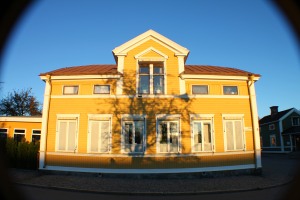 The Zeikos at 18 mm. It is close in coverage to the Sigma 12 mm above. This is the widest coverage you can get with the Zeikos – but you pay for it with a lot of vignetting and some barrel distortion – making straight lines bend.
The Zeikos at 18 mm. It is close in coverage to the Sigma 12 mm above. This is the widest coverage you can get with the Zeikos – but you pay for it with a lot of vignetting and some barrel distortion – making straight lines bend.
The Zeikos at 21 mm. This is very close to the coverage you would get if you do not want vignetting! There is a very small vignetting in the upper left hand corner that I did not see in the viewfinder when I took the picture. I have not marked the 18 mm coverage but as it covers almost exactly the house (see above) you can see that the extra coverage you get is quite small – a little extra sky and a little along the other edges. This is not much – at least if you have a 18 mm lens to start with! Having a lens starting from 22 mm you would get the advertised 0.45x (or a more common 45%) extra coverage area – without the vignetting. This Zeikos add-on is much better suited for a lens starting at 22 mm! But lenses starting at 22 mm are quite scarce!
This is very close to the coverage you would get if you do not want vignetting! There is a very small vignetting in the upper left hand corner that I did not see in the viewfinder when I took the picture. I have not marked the 18 mm coverage but as it covers almost exactly the house (see above) you can see that the extra coverage you get is quite small – a little extra sky and a little along the other edges. This is not much – at least if you have a 18 mm lens to start with! Having a lens starting from 22 mm you would get the advertised 0.45x (or a more common 45%) extra coverage area – without the vignetting. This Zeikos add-on is much better suited for a lens starting at 22 mm! But lenses starting at 22 mm are quite scarce!
.
Image quality
I took one picture each with the three different “lenses”. I have created two 100% crops, center and edge. The have been saved in PNG-format so that the picture quality should not be affected. I tried to get a similar coverage on all of them but I did not manage to get the exact same coverage … I had to pick the only focal length that was common – around 18-20 mm. Zeikos add-on was zoomed to 27 mm on the kit lens. Just click on the “tripple-crops” to see them in full size!
The center crop is alright on all three “lenses” I think. Thinking of the price difference they are all amazingly sharp and clear! There are small quality differences but not that much to complain about. Remember that this is a 100% crop from a 18 MPixel camera – meaning that the full picture would be over 1.5 meters (5 feet) in width on a normal screen – like you are probably looking at now! You make your own decission about sharpness at the center – but to my eye differences exists but are small enough to be ignored – if you have a good day! 😉
The edge crop is something different altogether! Here we can see really big differences on all three pictures! The Canon kit lens is by far the sharpest! Canon and Zeikos was stopped down to f 8.0 and the Sigma to f 11.0. This should be the “easiest” focal length for the expensive Sigma lens but it is not even near the Canon kit lens in sharpness – even though it is using f 11.0! But it is still way better than the Zeikos that is really blurry and is showing a lot of chromatic aberration (splitting up colours).
How does this translate to a picture of a normal size? Amazingly enough, scaled to fit on a 19″ screen with an IPS panel all three pictures are actually looking OK! Note though that there are differences! Both the Canon and the Sigma pictures are looking tack sharp! The Zeikos has just about acceptable sharpness around the edges, the blurriness is not so visible scaled down (as expected) but the chromatic aberration is more noticeable – in the light-dark transitions!
The close-up “macro” lens
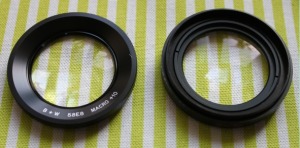 Unscrewing the rear part of the Zeikos Wide Angle “combo” gives you a rather powerful close-up or “macro” lens. You screw this single element lens onto your favorite lens and will be rewarded with the ability to focus much closer – how much depends on the focal length of the lens used. I used my trusty old 18-55 mm kit lens once again. I could have used my 55-250 mm also – because that also has a 58 mm filter fitting.
Unscrewing the rear part of the Zeikos Wide Angle “combo” gives you a rather powerful close-up or “macro” lens. You screw this single element lens onto your favorite lens and will be rewarded with the ability to focus much closer – how much depends on the focal length of the lens used. I used my trusty old 18-55 mm kit lens once again. I could have used my 55-250 mm also – because that also has a 58 mm filter fitting.
I wanted to compare the Zeikos with a proper close-up lens so I brought out my B+W Macro +10 lens. Both lenses have rather wide brims making them less than ideal for use with wide angle lenses. I wanted to see how different they were considering the price difference. The Zeikos – for “free” with the Wide Angle Add-on and the B+W for 380 SEK/40 EUR/$53. The question to answer is if the “free” close-up lens is anything to have?
I started by going as close as I could focus in wide-angle (18mm) to find out if there was any difference between the two close-up lenses. They were both very similar. This also pins the Zeikos in the area of -10 to -13 diopter – a little more powerful than the B+W lens. Both images look reasonably similar – both with powerful vignetting in the corners. The Zeikos has a little more barrel distortion along the edges. Middle sharpness (the only place where you will get sharpness with wide-angle) looks similar with both lenses.
With the kit zoom at 55 mm there is no longer any noticeable vignetting with either of the lenses. Centre sharpness is also quite similar even if the little darker exposure of the Zeikos makes that seem a little sharper when looking at it full-screen. Looking at the pictures pixel-by-pixel reveals that centre sharpness is as good with both lenses but that edge sharpness – though not very good – is slightly better with th B+W lens.
 Coming back to the question: Is the “free” Zeikos close-up lens is anything to have? In the real world – where you are not only photographing flat objects – I would have to answer a clear “Yes!”. You could actually buy the Zeikos wide-angle add-on just for the close-up lens! It is close to as good as the many times more expensive B+W lens! Does it give supersharp and crisp images?It does not affect the sharpness very much in the center of the picture but along the edges it certainly gives a definate blurriness! With as powerful close-up lens as this the field of depth is very shallow – which can be both good and bad – but being aware of it certainly helps – use it to your advantage!
Coming back to the question: Is the “free” Zeikos close-up lens is anything to have? In the real world – where you are not only photographing flat objects – I would have to answer a clear “Yes!”. You could actually buy the Zeikos wide-angle add-on just for the close-up lens! It is close to as good as the many times more expensive B+W lens! Does it give supersharp and crisp images?It does not affect the sharpness very much in the center of the picture but along the edges it certainly gives a definate blurriness! With as powerful close-up lens as this the field of depth is very shallow – which can be both good and bad – but being aware of it certainly helps – use it to your advantage!
My Conclusion
Is it worth the $13?
First of all I would say that a cheap add-on like this can be used just for some fun effects – and then you probably will not think too much of the disadvantages or might even consider them to be artistic advantages! Into Lomography perhaps …? 🙂
Secondly, using this on a zoom lens starting on 18 mm is a bit of a waste as you will have to zoom to around 22 mm before the vignetting disappears and that will only give you a corresponding 14.5 mm lens – and to get that very small wide-angle effect you have to put up with rather poor edge performance!
This lens is NOT something to use for serious photography!
Definitely not with the Canon 18-55 mm kit lens – it gives too little wide-angle increase while sacrificing a lot of quality along the edges!
If you have a lens starting at 22 mm or longer then you would not have to accept the vignetting! Also if you have a camera with a non-changeable lens it could definitely have its use – or a with a video camera!
Finally answering my own question: Is it worth the $13? (Note that the price matters much in this answer!)
I would say: Yes – for a 22 mm or longer lens! But be aware of its blurriness along the edges!
Counting also the close-up part of this Zeikos add-on makes this an even clearer “Yes”!
BUT this is ONLY as long as you do not expect a high quality lens for almost nothing…!
This is NOT a high quality lens – but it might be OK for you if you have low expectations!
 Power Pak 0.45x Add-On in part 2! Be sure to read part 2 – where you can see how to improve the result!
Power Pak 0.45x Add-On in part 2! Be sure to read part 2 – where you can see how to improve the result!
 EMOLUX 0.45x PRO HD Add-On! NEW Review of a higher quality wide-angle add-on!
EMOLUX 0.45x PRO HD Add-On! NEW Review of a higher quality wide-angle add-on!
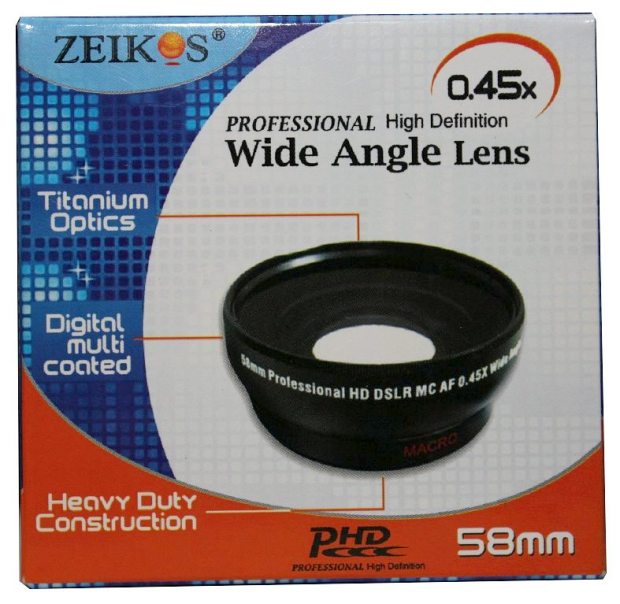
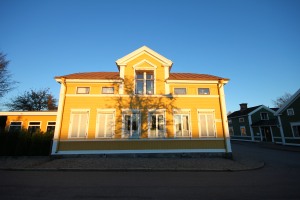

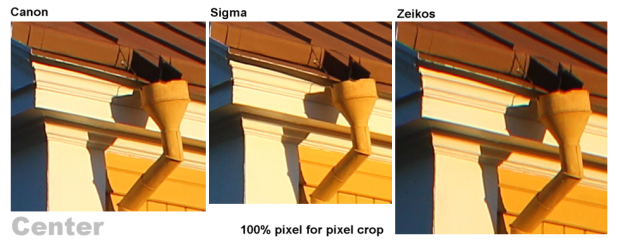


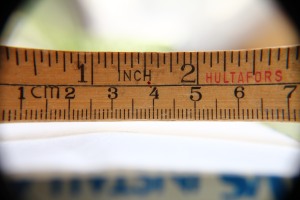



#1 by Matt on February 21, 2011 - 01:07
Thanks for explaining the 0.45x part – I thought wrong as you described above. I have a samsung fixed 30mm lens (NX10 camera) and was hoping for something around 13-14mm – yeah nah, I got around 24mm at best, but no vignetting. I’m probably going to throw the wide angle part out and keep the macro lens – so far I’ve had good experiences with it. Cheers
#2 by sfennl on February 24, 2011 - 03:34
Yes, it is a devious way of describing it! VERY easy to misunderstand!
Glad I could help!
#3 by eszra on March 28, 2011 - 14:04
I bought this lens but don’t have it yet. I think you could make it look allot more like the Sigma doing the following in PS:
-canvas size increase
-lens distortion filter
-crop
I’ll give it a shot when my filter comes in and let you know how it works (my guess is a nicer looking pic when zoomed out but even worse edges zoomed in…)
#4 by sfennl on March 28, 2011 - 23:22
I looked at your site! Really nice pictures!
Good luck with the wide angle lens!
/Photoman
#5 by aaanouel on October 4, 2011 - 15:49
After reading this review I purchased it and didn’t return it right away because of more expensive for me.
Thanks for nothing PhotoMan!
It could only serve on old not HD home video cameras but for still digital cameras it is TOTALLY USELESS.
It focusses ONLY at the very center of the image (15% perhaps?) and quickly degrades (a lot) towards the borders, chromatic aberration is quite strong. The same goes for both: Wide and Macro lens and for their clones as Neewer branded and others. Simple and pure filth!
Do not buy it, don’t waste even those few bucks!
You’d better purchase a bulk of toilet paper, at least you’d use it one time.
#6 by sfennl on October 4, 2011 - 19:20
Hi aaanouel,
You might have read my review but I am not sure that you have taken in what it said…
Even if you are using much stronger words than me, we have both arrived at roughly the same level of “quality” (if that is what you call it) for this add-on lens.
We both think that it is not to be recommended for serious photography!
You then think the lens is absolutely wortless – I on my hand think that it might be worth the “few bucks” for “fun effects” and that the serious flaws might be considered artistic adavantages – a little like many of the “Lomography” filters and apps that exists.
But if you require higher quality it might be better to buy a proper wide-angle lens and process the pictures afterwards for any effects you might want! (But at a much higher price!)
Also I think that the close up lens (with its flaws!) is an added (small) bonus – and is definately better than the wide angle add-on.
Aaanouel, I am sorry that you did not get the information you needed from the review – as was my intention! I will put up a few more samples and add some more (and stronger 😉 ) comments to make it easier to make a well informed decision.
Anyhow, thanks for your comment!
Photoman
#7 by aaanouel on October 4, 2011 - 21:38
Hi PhotoMan
I did read carefully your review and many times.
I have to recognize it is quite a good review and you honestly give all the pros and cons but I possibly wanted to hear the good aspects more than the not so good ones (my fault) and was finally convinced by that big “Yes” at the end of your review, so when I purchased it I expected the lens to be a little better than it really was and my disillusion has been very strong.
You have win many good points with me, you have demonstrated to be an honest person and surely didn’t deserved my hard words (but the lens), so excuse my temperamental attitude, is not usual in me.
Anyway, I still think the lens itself is really bad, it does deserve my ugly words and don’t worth the few dollars it cost and I personally wouldn’t recommend to anybody to buy it.
I really appreciate the answer and accept the deserved scolding.
Thanks.
#8 by sfennl on October 4, 2011 - 22:04
Hi Aaanouel,
Thank you aaanouel for your very kind reply! 🙂
It certainly cheered me up – and I will surely add a little “warning” so others will not fall in the same trap that you did! Sorry about that!
Photoman
#9 by aaanouel on October 5, 2011 - 02:40
Well PhotoMan, as you said, after all is so cheap that tempts give it a try so no real surprise with the results. So few bucks should have not produced so angry reaction, but they did and now it’s already forgotten.
Friends.
#10 by sfennl on October 5, 2011 - 07:00
Definately friends aaanouel!
PhotoMan
#11 by aaanouel on June 8, 2012 - 21:50
Just passed by again and wanted to give you a big Hello!.
Cheers!
#12 by sfennl on July 2, 2012 - 17:48
Hey aaanouel,
Nice that you dropped by!
Do it as often as you like! 😉
Photoman
PS Adding that I have used the wide-angel lens very little since I bought it! The close-up part works OK in everyday photography – not taking pictures of flat objects.
#13 by Russ on October 31, 2014 - 22:55
Good review. The lens is what it is, just a cheap toy really. I bought one for my young son to use on his Panasonic G2 and kit lens. He loves it and i don’t care what happens to it. You’d have to be pretty daft to expect the performance of £350 wide angle lens like the Sigma 10-20 from a £10 adapter. I think you called it right. It’s a worthwhile purchase for the right application.
#14 by sfennl on November 4, 2014 - 00:44
Thanks for the kind words Russ! It is always nice with a little feedback! Especially positive! 🙂
Glad your son is happy with it! I tend to use the close up lens mostly!
#15 by Julian Pegg on February 24, 2015 - 09:24
Hi
I bought a similar product for my Canon 1100D and thought I would tryit out last night on a few things in doors. My problem was that I got blurry images at whatever length i used. Tried manual and auto focus. Auto didnt work at all? Then it said it was “busy” and the button for taking the photo would not depress.
What am I doing wrong? I tried it on the auto setting aswell as AV.
I am fairly new to photography but would have assumed I could just attach and click away.
This happened with both the wide angle and the macro. I did notice that the macro has two threads to it, can it be used both ways?
Please give me some advice so I can get the most out of this. Ideally I would have loved a complete wide angle lens but I dont have a spare £250.
Thanks
Julian
#16 by sfennl on February 24, 2015 - 21:54
Hi Julian,
Sorry to hear you have a problem! We should be able to sort this! It should really just be as you said: “attach and click away”.
First of all: BOTH the “wide angle part” and the “macro part” should be used screwed tightly together – to get the “wide angle lens” to work! That is what the double threads on the macro part is for. You screw it on the back of the wide angle part with one set of threads and screw it on the camera with the other – the threads look very similar … might you accidentally have screwed them together the wrong way?
You screw them apart ONLY to use the macro part – and that – I would say will always work! Remember that the focus is VERY close to the front of the lens, just a few centimeters (or inches).
This is a good way to use the macro lens: Just look through the viewfinder and move the camera closer and closer till you get a reasonably sharp picture – remember to go VERY close, almost touching your object! Then when you have a reasonable focus you might press the focus/release button to get it to fine adjust your “manual” focusing – practice a little with this and you will get the feel for it! It is really easier just to move the camera because the sharp distance is really really shallow!
I hope that the above will solve it for you! In case not we are in a stickier mud of a problem …
The wide angle lens is quite “heavy” so focusing pointing directly down and straight up might be a problem – I have just discovered! But probably, I guess, you have focusing problems all the time..?
You could try the following:
I found it quite difficult to get it to screw on (to catch a thread) properly. It should attach very snuggly when you screw it on. In case it does not fit snuggly, try turning it anticlockwise to get it to settle/”jump” into a thread, before screwing it on clockwise. It is VERY easy to damage the thread groves so be careful!
Make sure the close-up lens part (the rear part) and the rest of the “lens” (the front part) is screwed tightly together. <– This is certainly something that will affect focus!
Hope any of the above helps … I will try to dig out mine and see if I can come up with any more hints on what to try!
Let me know if any of this solved you problem!
Good luck!
/Photoman
#17 by Somu on March 6, 2016 - 04:49
I read this posting after i just got one cheap wide angle add on in my hand.Got it for 1054 Indian rupee (Approx 15 Dollars), its brand name is “Powerpak” and is from China.For the price its physical quality appeared great and for looks crystal clear glass.Not believed in multi coating etc claims.I took the experimental shots on my Nikon D5200, 55-300mm VR DX lens at 55 position with & without the wide add on.While increased wide is impressive the image is blurred away from center towards left & right, interestingly top & bottom portions are OK.Thought the result may be due to DX frame lens and the add on may not be good at 55mm focal length.Then next tested with Vivitar 28-80mm manual lens which is of full frame lens.The results are quite surprising.Shot at 28mm.The increased wide is quite impressive with fish eye effect as expected towards outer but image sharpness is impressive and worthy compared to shot with 55-300mm lens taken at 55mm which is useless.Though am not a pro i concluded for self that the add on is good only with already wide angles lens like 28mm making them fish eye but no good for prime focal lengths and above.Of course this is not my final conclusion as i have some more lens to test with but waiting for suitable adapter ring to use this add on.I read this posting and found a lot interesting, informative and useful.Thought sharing of my experiment.I feel it will be more interesting to share the experimental pictures taken by different enthusiasts on different cameras & lenses.Am ready to share mine.Am a photographer since 1980 and used to do all dark room work.Feel nostalgic to take pics with manual lens and with manual settings to feel like living in the past.Use both auto & manual settings equally.My sincere thanks to Photoman
#18 by sfennl on March 11, 2016 - 21:34
Somu, it is very interesting to hear of your experience with a wide angle add-on! My experience is, as you have read, similar to yours – but I have not tested it with a full frame lens! For shorter focal lengths I got very powerful vignetting, but from about 22 mm and up I got a usable picture without much vignetting. So using it with a 28 mm lens should be a good use for the wide angle add-on – if you are willing to accept that it is not ideally sharp all over the picture!
I have started to very often take panoramic pictures as a sort of “alternative” when I do not carry with me the heavy Sigma 10-20 mm or the wide angle add-on. It is of course not a proper full replacement – but for stationary motifs I enjoy the panoramic wide screen view very much! As experienced as you seem you have probably already tried it – but if you have not tried to take the panoramic pictures you should definitely do that! 🙂 Just take a few overlapping pictures and join them together with the Microsoft ICE software. See my article on the subject!
I too feel sometimes a little nostalgic when I think back to the days of dark room work and waiting to see the pictures! But I have fully adopted to digital photography now! I would not like to go back! How about you?
Once again thank you for your interesting and kind comment!
Photoman
#19 by Somu on March 12, 2016 - 03:42
sfenni, Many thanks for your response.28mm lens with add on wide angle resultant picture have no vignette.Sharpness is better than acceptable and is almost comparable to the image w/o add on.The image with 55-300 DX lens @ 55 is only clear at center and the effect is like using center image filter.Its macro part is really good and appears to work as 8x.Used stand for snap as even minor shake resulting in out of focus.
A my cheap intex android phone camera has panorama mode.In that mode the phone to be hold reasonably steady and moving around to cover the area we want panorama.Even w/o stand it gave amazing pic instant.Just wonder whether any digital camera has similar function.I have tried panorama and stitched them in photoshop.
Fully happy with Digital photography but at times feel challenge to click in fully manual mode along with manual lens to keep alive old day skills.Put all old film cameras in a show case at home and visitors are curious to look at them.Old enlarger now using for converting negatives to digital by just clicking film snaps in macro.
Regards
Somu
#20 by sfennl on March 12, 2016 - 19:11
Somu, very interesting to hear of your use of the old enlarger!
I have many old negatives and many slide pictures that I sadly just keep in drawers today!
When you convert your negatives with the enlager – do you use it as a “projector” and snap pictures of the enlarged projected image (where the paper used to be placed) or do you take pictures directly of the negatives?
I have no enlarger anymore but I have been thinking of converting my old slide projector and fit the camera with a macro lens and take pictures of the slides/negatives directly. It sounds a little like you do… Are you satisfied with the result? Do you think I would be successful with the use of a slide projector? Do you have problems with dust? My slides always seem to have some dust!
Regards
Photoman
#21 by Somu on March 13, 2016 - 03:25
Dear sfenni,
I have directly taken pictures of the negatives.Taking pic of projected image is difficult and is not bright enough like negative.I just removed the enlarger part below negative carrier.When faced problem with some single negatives which have some shape deformation i put them in between two plain glass with due black masking only to project negative.Fortunately most of my negatives kept well in folders and many are OK.yes some have dust.I just washed in water and hanged them dry and later took pics.In front of enlarger condenser i put a diffusing white plastic sheet to avoid center bright spot.B&W negatives converting is a fun with just converting in software by convert negative option and choosing grey scale to remove color shades.But i faced converting color negatives quite complex as negative color dyes changed over years.Color balancing quite tiresome.Some may never result in original colors.But many negatives i have no prints as they were given away.So something is better than nothing.So i did it.But after seeing many pics on PC again am so much amazed and even felt like when i took them all.Some pics brought back priceless lost memories.All the negative conversions i did with my Nikon L310 bridge camera which did great job and curiously Nikon L29 failed to focus.In comparison with real prints am 90% satisfied with B&W conversion and for Color many came 75% and some 50%.Some negatives kept in pvc like folders which were then supplied by the negative processing lab has developed acid formation spoiling the negative with round spots.Some color negatives damage so horrible and am content with changing them to B&W than seeing them in horrible stage.So you better check all your negatives at once to check their status.Better convert them ASAP and in particular color negatives.In fact also thought to experiment by giving some color negatives for lab printing but not done guessing the outcome.
Regards
Somu
#22 by sfennl on March 14, 2016 - 00:25
Dear Somu,
Thank you for you very interesting description of how you did the conversion! I will check my negatives at once! I am sure I also will relive past moments! I will also go the direct way with my slide projector and I was going to ask you about if you used something as a diffusor – but you have already answered that! 🙂 I was planning to use some kind of pressurized air to blow dust away! There will be quite a large work to convert the projector as I was hoping to use a small computer to do the actual shifting of pictures – via the projector remote control. I will see in the coming months if it is too complex and I will have to go the manual way after all! Which camera will be best I do not know at the moment I have an old Canon EOS 350D that I am not using any longer and a little compact Canon Powershot s95. Would have to use a close-up lens with the 350D. Have you used the automatic exposure and auto focus?
Regards,
Sfennl
#23 by Somu on March 14, 2016 - 04:08
Dear sfenni,
Am happy to know that my experience is interesting you.First i thought of buying a film scanner and did some net survey.One day felt like my enlarger is sadly looking at me and forced me to make some use of it.Then it is resulted in negatives conversion.The enlarger diffuser should not result in any uneven brightness on the negative but in the image developed i saw center bright area.So a pvc white sheet solved the problem.I wish to suggest to try all cameras with you once and you know which is better for this specific job.Some times focusing may be a problem but we can try moving the camera to point different spots of the negative to get focussed then centering to negative.I carried all my conversions by holding camera in hand.Results are fairly good.Thought of fixing the camera at constant position locked for precise results all the time but not done as satisfied with hand shoot result.The care we need to take is maintain parallels between negative & camera to avoid distortion.For all the conversions i used the software “Faststone image viewer” which is good enough.I use photoshop only for specific complex jobs as required.Yes dust cleaning with air pressure is a good option, we may use a soft brush also.But when something is sticky on the negative water wash and drying is the only option left.There are many postings over net reg negatives digitalization without film scanner.Here is an youtube link which may be interesting: https://www.youtube.com/watch?v=kj7Em7VNHfU
I consider my self as neither amateur nor a pro.But mad with photography and cameras.Am a Mechanical engineer with huge and wide experience with specialization of problem solving with experimenting.Once in the past modified my Yashica Electro 35 camera 5.6V mercury cell power to 6v DC power by taking supply from flash gun which run with 4 AA.Once original 5.6v battery exhausted i never bought again the battery.Electro 35 used to work even w/o battery at constant 1/100 speed and manually deciding the aperture.Now with my Nikon D5200 experimenting with worst rated lenses of Vivitar 28-210mm & 28-80mm to get good pictures !.I got these lens at throw away price and in mint condition.They are new old stock.They look so beautiful than my Nikon lenses which looks plastic.I put a competition between Nikon & Vivitar lens.For few shots Vivitars won due to their manual flexibility compared to Nikon kit lens.I wish to have your email to share some specific pics and info.I promise not to spam your mail.
If am writing too much please excuse me.It is like addiction.
Regards
Somu
#24 by sfennl on March 15, 2016 - 19:35
Dear Somu,
Once again you make interesting comments! You have a steady hand! I did some initial testing a year or so ago with building a cardboard holder and converted just one or two slides – just to see if the quality was good enough by snapping pictures with a camera instead of going with a proper (and VERY expensive) slide scanner! The results were very promising but I have not mustered up the energy to modify my slide projector yet! The engineer side of me would want to automate the process as much as possible – but that takes a LOT of time before it pays of in any result! The reason I want to automate it is that I have a few thousand old pictures … 🙂
Thanks also for the youtube link! Amazing that it can be done so easily!
Regards,
Sfennl
#25 by Somu on March 14, 2016 - 16:23
Dear sfenni,
Once again am coming back to the subject matter of “Add on wide angle lens” with some interesting observations.This day i took some more test shots with other lens after i got my new 52-58 step up ring.I purchased 58mm wide angle lens with a view to use it on 58mm filter thread and also on 52mm thread with this adapter.Earlier i tested only on Nikon 55-300mm DX lens and Vivitar 28-80mm FX manual lens.Once again am summarizing all my testings.
Camera : Nikon D5200
1.Nikon 55-300mm DX Lens @ 55
mounting : Lens+UV+Wide
Subject : Far away
High blur towards left & right than top & bottom.Image is OK like a circle with dia nearly equal to hight.No vignette.Barrel effect is not noticeable.Image usability is only if we need such pic.What ever wide it gives is almost blur.Going above 55mm no focus at all.
2.Vivitar 28-80mm FX manual lens @ 28
Mounting : Lens+UV+Wide
Subject : Far away
Image is quite OK with no vignette & noticeable blur but is with obvious barrel effect.
3.Nikon 35mm 1.8 DX lens
Mounting : Lens+UV+52/58 ring+wide
Subject : 16ft
Moderate blur towards left & right and moderate barrel effect.
4.Nikon 18-55 DX Kit lens
Mounting : Lens+UV+52/58 ring+wide
Subject : 16ft
18 to 24 vignette, with very high at 18 and disappear at 24.Looking in the view finder itself not tried shot in this range.At 24 no vignette but with expected moderate blur towards left & right and high barrel effect.When comparing to a shot without wide angle add on but at 18 of the lens the image taken with add on at 24 is wider.So this made me to assume that the highest wide the add on can do without abnormal distortion is around 24×0.45 = 10.8.Or we may take it as 11mm lens.But with below 24mm lens it won’t be w/o vignette.
5.Zenit Helios 58mm, 2.0 lens
Mounting : Nikon/42mm adapter+Lens+UV+49/52 ring+52/58 ring+Wide
Subject : 16 ft
This gave me biggest surprise.It gave no barrel effect, no vignette and there is no blur.
After all these my assumptions are like this : The wide angle add on is good on short body FX lens.The longer the lens the more the blur.It will do better without vignette with range from 24mm to 60mm or so lens.It is good on FX lens than DX lens.We can’t generalize the add on lens but it is to be seen on each lens individually and how it is used with all variable like lens length, focal length, intermediate accessories used etc so on.However it is quite worth for the price it is available.
Am not a pro and all these write up is for the purpose of thought provoking and experimenting.I just expressed my mere assumptions and can’t prove scientifically.
Regards
#26 by sfennl on March 15, 2016 - 19:51
Dear Somu,
I thank you for sharing your findings! When I read through you writing I realized that I did not test to see if using wide or small aperture affects the sharpness … One thing I did see when I set the camera up to take my test pictures was that the aperture affected the vignette very much! I will see if I get nice weather I will add a couple of samples to illustrate the effect!
Regards,
Sfennl
#27 by Paul C on October 19, 2017 - 09:52
Dear Photoman – Just the perferct review that I needed:
[1] Does it work?
[2] Does it match the claims made for the product?
[3] what is the image quality?
[4] What are the strengths and weaknesses of the product?
[5] What does it cost?
[6] How does it compare to the alternatives?
You ticked all the boxes for a product evaluation – and added a great writing style – and you have kept it posted for more than 5 years! Respect to you Sir !
#28 by sfennl on October 19, 2017 - 15:38
Hi Paul C,
I am glad that you liked the review! It is by far the most read review I have ever written! 🙂
A great thank you for writing the comment! It is what keeps me going!
/Photoman